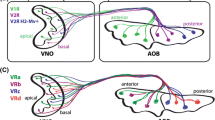Abstract.
In addition to the main olfactory system, many vertebrates possess a vomeronasal system that conveys more specialized chemosensory information. Unlike the airborne, volatile stimuli detected by the main olfactory system, vomeronasal stimuli are typically proteins of the lipocalin family which bind small, volatile ligands. Despite the smaller number of vomeronasal receptor types, the projection patterns of the vomeronasal receptor neurons to multiple glomeruli in the accessory olfactory bulb appear to be more complicated than those of the main olfactory system. The vomeronasal system has a direct sub-neocortical projection to hypothalamic areas that mediates specific behavioural and hormonal responses to pheromonal stimuli. However, the integration and transmission of this information can be modulated by learning mechanisms. The aim of this article is to outline some of the functions of the vomeronasal system, and in particular to comment on recent advances in our understanding of how vomeronasal information is coded and processed.
Similar content being viewed by others
Author information
Authors and Affiliations
Additional information
Rights and permissions
About this article
Cite this article
Brennan, P. The vomeronasal system. CMLS, Cell. Mol. Life Sci. 58, 546–555 (2001). https://doi.org/10.1007/PL00000880
Issue Date:
DOI: https://doi.org/10.1007/PL00000880




